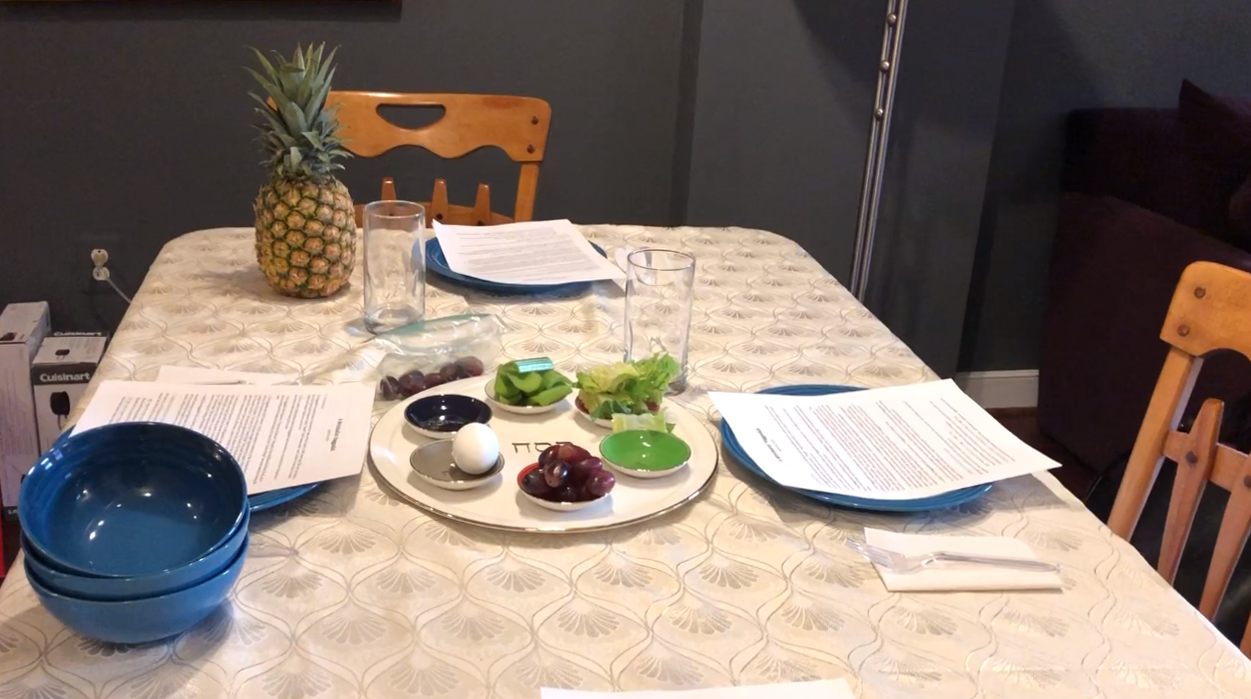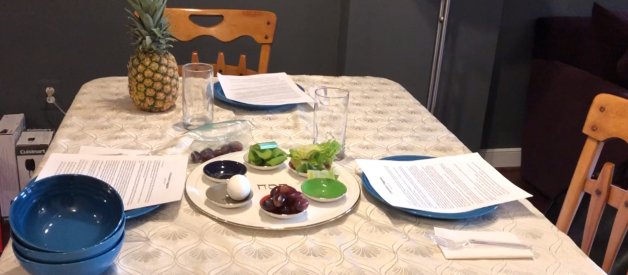A short and somewhat secular take on the traditional Passover Haggadah.
For the motivation that led me to write this Minimalist Haggadah, please see:
My search begins for a new Passover Haggadah
What I?m looking for in a Haggadah and a link to my Minimalist Haggadah.
medium.com
I developed this Haggadah with no formal experience in Jewish scholarship but an interest in getting the key components of the Seder locked down before trying other modern alternatives. I used this Haggadah with Leah and some friends on April 24, 2019, and I will update it below from time to time as I learn more.
A Minimalist Haggadah starts below. Please feel free to print and share this, and please share your modifications with me so that I can learn from them.
 Getting our Seder table ready.
Getting our Seder table ready.
Notes for the Seder Leader (You)
The Haggadah is a very old Jewish text written in Hebrew and Aramaic originally around the year 300 CE that was read by our ancestors on Passover. (There are several versions of the Haggadah from different parts of the world but they are all very similar, and modern English Haggadahs are generally identical except for their English translations and illustrations, which can be quite fanciful.) The Haggadah is a guide to the observance of Passover. It is a collection of poems and songs, excerpts from the Torah, and discussions by rabbis of long ago about the meaning of the Exodus story and how to remember it. Traditionally, the Haggadah is read start-to-finish on the first two nights of Passover. For those who have studied the text and have the patience, there is much to learn and experience by reading it twice again each year. But for the rest of us, there may be a better experience in a shorter and more focused observance.
In creating this Haggadah, I looked for what the Torah and the traditional Haggadah itself tells us to say and do during the Passover Seder:
- The Haggadah calls Passover ?a holy convocation in memory of the Exodus from Egypt.? The recalling of the Exodus story, from the book of Exodus in the Torah, is a central component of the Seder. In the Exodus story, which takes place three or four thousand years ago, God frees our ancestors from oppression by Egypt?s Pharaoh. The book of Exodus commands that its story be retold ? making that one of two biblical mitzvot specifically related to this holiday. The Haggadah itself says that the sacrificial lamb whose blood plays an important part of the story is the first of the ?three things? that must be mentioned during the Seder. The lamb is represented in the Seder ritual by the afikoman (Hebrew for dessert), which is the name we give to a piece of matzah designated as the last dessert. (This not to be confused with either the ?Passover sacrifice? or the ?festival sacrifice,? which refer to two sacrifices made during Passover celebrations in pre-rabbinical Judaism, when the Template was still in existence. The ?Passover sacrifice? symbolized the lamb in the Exodus story, and modern Haggadahs typically describe the ?shank bone? on the Seder plate as representing this latter sacrificial lamb. The ?festival sacrifice? was a second sacrifice, also made on other holidays, which is represented by an egg on the Seder plate.)
- Each person at the Passover Seder ?is obligated to see [yourself] as if [you] left Egypt? yourself. In other words, we must not merely tell the Passover story. We are supposed to tell the story in a manner that leads each participant to imagine and feel themselves being liberated right then. (Indeed, the traditional Haggadah does not recount the story in whole or even in order.) Eating maror, a bitter green food to represent the bitter times of our ancestors in Egypt prior to the Exodus, is a part of experiencing the Exodus story here ? it is the third of the ?three things? that we must mention during the Seder. The Haggadah says we should also be relaxed to enjoy the feeling of liberation.
- The Haggadah also calls Passover a ?Festival of Matzah.? Matzah is the traditional holiday food, and it has a recurring role throughout the Seder. It is the second of the ?three things? we must mention during the Seder, and the book of Exodus also commands that matzah be eaten on Passover, making it a mitzvah (which is considered achieved at the motzi-matzah stage of the Seder).
- Lastly, the Haggadah tells us to thank God for God?s role in rescuing our ancestors from oppression.
Because of the focus in this minimalist Haggadah on the rules for Passover as dictated in the Haggadah itself, the traditional Haggadah?s formal conclusion, roughly translated as, The seder is now concluded according to the statutes, is particularly on-point.
Although drinking wine is a recurring part of the traditional Seder because it has long been viewed as a celebratory drink, it?s not something that everyone can enjoy (in particular, those who choose not to drink alcohol, who are pregnant, who are not of the legal age, or who can?t consume alcohol for health reasons). For this reason, I give an alternative, eating a grape, at each instance where a cup of wine would normally be. Please make sure that you will have something available that each of your participants will be able to consume in celebration at the indicated parts of the Seder.
My last unique contribution here is that instead of praising God toward the end of the Seder, I have replaced that with reflecting on our obligation to help those who are not yet liberated. I?m a secular Jew and this fits my sensibilities, but you may want to add some praise back, and of course that?s fine.
A few notes about reading the Hebrew prayers. If you can read the Hebrew, great, but if you can?t, don?t fret because below most of the Hebrew, you?ll see transliterations, which are English letters for the sounds in the Hebrew prayers. In the transliterations, you?ll see the letter ? with the dot under it: This is pronounced like you?re choking. (In other texts you often see this same sound written as ?ch? instead. Same sound.) For everything else, just pronounce it as you see it. One Hebrew word isn?t translated exactly, and that?s the word ???? which is God?s true name. We don?t know the correct pronunciation for God?s true name, so we say ?Adonai,? meaning the lord, in prayers instead (both in Hebrew and English). But this too is a name for God, and Jewish law says that God?s name should not be destroyed. Consequently, if you print out this Haggadah, Jewish law would say that you must bury it in a white shroud if you want to discard it. You may have Jews at your table who observe this. Using an iPad instead of printing this out on paper might avoid this problem ? though observant Jews cannot use electronics on the first two days of Passover. So please be sensitive to this, depending on your and your participants? practices.
Read this through before your seder because you?ll need to have some particular food and drinks at the table.
You may want to share some or all of the above with your participants, as much as you think is appropriate.
The Hebrew and humanist prayers are adapted from the Sefaria.org Haggadah and A Haggadah of Our Own by Thursday Bram, respectively, and I also used OpenSiddur.org?s translation of the Haggadah by Eve Levavi Feinstein and Efraim Feinstein as a reference. And of course the thoughts and emphasis are based on reading a lot of other analyses of Passover.
The Minimalist Haggadah begins next.
0. Introduction
Welcome to our Passover Seder. ?Seder? is the Hebrew word for order, and the Passover Seder is so named because all Passover Seders go through similar steps in a similar order.
The Haggadah is a very old Jewish text, written in Hebrew and Aramaic, that was read by our ancestors on Passover. The Haggadah is a guide to the observance of the Passover holiday, and it tells us what must be said and done on Passover, and we use its order and directives to guide us tonight. We will be doing an abridged Seder. Rather than following the text of the traditional Haggadah, we will be proceeding through the same steps but focusing on three obligations that the traditional Haggadah gives for properly observing Passover: telling the Exodus story, experiencing the Exodus story here tonight, and eating matzah.
To get you thinking now, when we get to the part about experiencing the Exodus story here and now, I?m going to ask each of you to think about suffering you have experienced and a time of liberation you have experienced, so you can start to think about what memories you want to recall before we get to that point.
We?ll now start the standard Seder steps.
1. Kadesh (sanctify over wine)
We begin by sanctifying this time and saying thanks for wine and for this holiday, the festival of matzah. We will do this in the traditional form, first in Hebrew then in English:
.???????? ?????? ????, ?????????? ?????? ???????? ??????? ?????? ????????Baru? atah Adonai, eloheinu, mele? ha-olam, borei p-ree hagafen.Blessed are You, Lord our God, King of the universe, who creates the fruit of the vine.
.???????? ?????? ????, ?????????? ?????? ????????, ???????????? ???????????? ????????????? ???????? ??????Baru? atah Adonai, eloheinu, mele? ha-olam, shehe?eyanu vekiyimanu vehigiyanu lazman hazeh.Blessed are You, Lord our God, King of the universe, who has granted us life and sustenance and permitted us to reach this season.
We each now drink a cup of wine or eat one grape. Savor the wine or the grape because unlike our ancestors in Egypt, we now enjoy the liberty to do so.
2 Ur?atz (wash)
The Seder leader will symbolically wash their hands.
3 Karpas (spring vegetable)
We will now dip a piece of celery into salt water and eat it. The celery is to remind us of spring. The salt water is to remind us of the tears of our ancestors enslaved in Egypt. As you eat, I will say the traditional prayer:
.???????? ?????? ????, ?????????? ?????? ????????, ??????? ?????? ?????????.Baru? atah Adonai, eloheinu, mele? ha-olam, borei p-ree ha-adama.Blessed are you, Lord our God, King of the universe, who creates the fruit of the earth.
4 Ya?atz (break)
.??? ??????? ??????? ???? ??????? ??????????? ????????? ???????????. ???? ???????? ?????? ????????, ???? ????????? ?????? ?????????Ha la?ma anya di a?alu avhatana b-ara demitzrayim. Kol di?fin yeitei veye?ol. Kol ditzri? yeitei veyifsa?. [This prayer is Arameic.]This is the bread of destitution that our ancestors ate in the land of Egypt. Anyone who is famished should come and eat, anyone who is in need should join us.
I have here three pieces of matzah. I will break the middle piece into two. The larger one is now the afikoman, our dessert, which I will wrap and put aside. The afikomen represents the sacrificial lamb in the Passover story, which we?ll get to next.
5 Magid (the story)
The recalling of the Passover story is the central component of the Passover Seder, and there are a wide range of traditions in how the story is told. The book of Exodus in the Torah is the Passover story, and we could simply read Exodus next, but that would miss the point and take quite a while. In the traditional Haggadah, parts of the story are related several times, from different perspectives, and in different levels of detail. The point isn?t to read the story as it?s found in the Torah, but to retell it in a way that makes meaning to each of us here tonight.
First, let?s get the basics. The Haggadah begins the story with Jacob, the grandson of Abraham, the father of the Jewish people (and who lived before Jews were ?Jews,? in Canaan). Jacob?s name was changed into ?Israel? in a story in the book of Genesis, and his descendants are called Israelites, which is what you need to know to understand the start of the Exodus story:
Jacob and his sons went down to Egypt ??????? ???????? ??????? ????????? since the famine was heavy in the land of Canaan. ???? ????? ??????? ???????? ???????? And he became a nation of people. ??????? ???? ??????. And Egyptians enslaved the Israelites with breaking work. ?????????? ????????? ?????????? ?????????? ?????????
Fast-forwarding, God decides to free the Israelites by making life so hard for the Egyptians through ten plagues that they agree to let the Israelites leave. God instructed the Israelites to sacrifice a lamb and mark their doors with its blood so that God would pass over those houses and spare them from the last plague. While the Egyptians were suffering, the Israelites escaped into the dessert and headed toward the land of Israel.
We remember the sacrificed lamb not only as the afikomen but also as the bone on the Seder plate.
We?ve now retold the Exodus story, but we haven?t felt as though we were in the land of Egypt ourselves. So we?ll pause here, and I ask that each of you recall a time of suffering or oppression in your own life. And I ask that you keep that memory with you over the next few minutes.
With this in mind, please drink your second cup of wine or eat your second grape.
6 Rohtzah (wash before matzah), Motzi (blessings over the Matzah), and Matzah
We now wash our hands before eating matzah for the first time tonight.
When the Israelites left Egypt, they were in a hurry to get away from the Pharoah?s army. While on the run, they made matzah. Matzah is plain, rough, and fragile. It symbolizes the harsh journey of the Israelites out of Egypt, through the desert, to Israel. Keep thinking about that memory of suffering or oppression as you eat a piece of matzah, from either the top piece or the remaining part of the middle piece of matzah.
7 Maror (bitter herbs) and Kore? (sandwich)
Hold onto your memory of suffering or oppression as you eat the foods symbolic of the hard times in Egypt, the maror ? the bitter herbs, in our case romaine lettuce ? and the ?aroset ? in our case, the almond butter ? which represents the mortar from the hard labor in Egypt when the Israelites were building the pyramids (I guess!). Using matzah, eat it as a sandwich.
8 Shulchan Orech (the meal)
We escaped from Egypt. We did it. Wash away that memory of suffering or oppression. We?re a liberated people now. Please recall now a memory of liberation and hold that memory for a moment.
Then feel free to stand up, pour your neighbor a glass of wine, or help serve the Seder meal.
Please start your meal with a piece of egg ? the last item on the Seder plate to be eaten. It is often said that the egg represents the celebrations of Passover at the ancient Temple in Jerusalem. The Temple was subsequently destroyed, twice, about 2,000 years ago, and following the destruction of the Temple the old Israelite traditions of animal sacrifice transformed into the symbolic traditions of Judaism that we have today, and in this case, animal sacrifice became a cooked egg.
9 Tzafun (eating of the afikoman)
With the meal complete, we can how have our last dessert. We now eat the afikoman. Remember that the afikoman represents the sacrificed lamb that helped God spare the firstborn of the Israelites, during the last of the plagues, and so it is fitting to be our last dessert.
10 Barech (blessing over the wine)
We now drink our third cup of wine or eat our third grape. Enjoy the wine or the grape, for we are free.
11 Hallel (praising God)
This part of the Seder is traditionally for praise of God, in particular for God?s role in freeing the Israelites from oppression.
Why did God free the Israelites? The Exodus story is often told as a story of justice. But another answer may be in this line from the traditional Haggadah and the book of Exodus: ?God remembered his covenant with Abraham,? the father of the Jewish people. In the covenant, God had promised Abraham that his descendants would rule the Land of Israel, something that would have been impossible if the Pharaoh in Egypt kept them enslaved forever. It seems that, at least in part, God frees the Israelites not because of justice but because of obligation.
We can honor the tradition of praising God by reflecting now on our obligations as a liberated people to help those who are not yet liberated. Let?s keep in mind that as a liberated people, we may now benefit from the oppression of others. We might even unwittingly be the hand of oppression ourselves. The work to liberate all people goes on.
We now drink our fourth and last cup of wine or eat our fourth and last grape.
12 Nirtzah (completion)
We?ll now conclude the Seder:
.????? ??????? ?????? ????????????, ?????? ??????????? ??????????.The Seder is completed according to its laws, judgments, and statutes.
.???????? ???????? ?????????????? ???????????Next year, in Jerusalem.
Next year with freedom for all! [Adapted from humanist ending in Bram?s Haggadah.]


